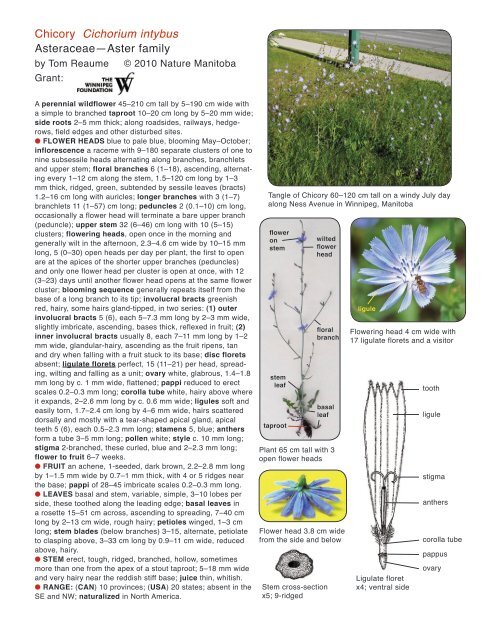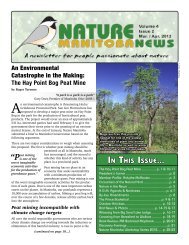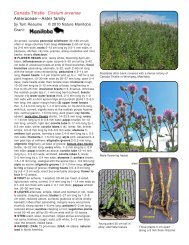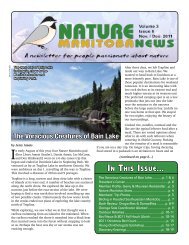Chicory Cichorium intybus Asteraceae—Aster ... - Nature Manitoba
Chicory Cichorium intybus Asteraceae—Aster ... - Nature Manitoba
Chicory Cichorium intybus Asteraceae—Aster ... - Nature Manitoba
Create successful ePaper yourself
Turn your PDF publications into a flip-book with our unique Google optimized e-Paper software.
<strong>Chicory</strong> <strong>Cichorium</strong> <strong>intybus</strong><br />
<strong>Asteraceae—Aster</strong> family<br />
by Tom Reaume © 2010 <strong>Nature</strong> <strong>Manitoba</strong><br />
Grant:<br />
A perennial wildflower 45–210 cm tall by 5–190 cm wide with<br />
a simple to branched taproot 10–20 cm long by 5–20 mm wide;<br />
side roots 2–5 mm thick; along roadsides, railways, hedgerows,<br />
field edges and other disturbed sites.<br />
l FLOWER HEADS blue to pale blue, blooming May–October;<br />
inflorescence a raceme with 9–180 separate clusters of one to<br />
nine subsessile heads alternating along branches, branchlets<br />
and upper stem; floral branches 6 (1–18), ascending, alternating<br />
every 1–12 cm along the stem, 1.5–120 cm long by 1–3<br />
mm thick, ridged, green, subtended by sessile leaves (bracts)<br />
1.2–16 cm long with auricles; longer branches with 3 (1–7)<br />
branchlets 11 (1–57) cm long; peduncles 2 (0.1–10) cm long,<br />
occasionally a flower head will terminate a bare upper branch<br />
(peduncle); upper stem 32 (6–46) cm long with 10 (5–15)<br />
clusters; flowering heads, open once in the morning and<br />
generally wilt in the afternoon, 2.3–4.6 cm wide by 10–15 mm<br />
long, 5 (0–30) open heads per day per plant, the first to open<br />
are at the apices of the shorter upper branches (peduncles)<br />
and only one flower head per cluster is open at once, with 12<br />
(3–23) days until another flower head opens at the same flower<br />
cluster; blooming sequence generally repeats itself from the<br />
base of a long branch to its tip; involucral bracts greenish<br />
red, hairy, some hairs gland-tipped, in two series: (1) outer<br />
involucral bracts 5 (6), each 5–7.3 mm long by 2–3 mm wide,<br />
slightly imbricate, ascending, bases thick, reflexed in fruit; (2)<br />
inner involucral bracts usually 8, each 7–11 mm long by 1–2<br />
mm wide, glandular-hairy, ascending as the fruit ripens, tan<br />
and dry when falling with a fruit stuck to its base; disc florets<br />
absent; ligulate florets perfect, 15 (11–21) per head, spreading,<br />
wilting and falling as a unit; ovary white, glabrous, 1.4–1.8<br />
mm long by c. 1 mm wide, flattened; pappi reduced to erect<br />
scales 0.2–0.3 mm long; corolla tube white, hairy above where<br />
it expands, 2–2.6 mm long by c. 0.6 mm wide; ligules soft and<br />
easily torn, 1.7–2.4 cm long by 4–6 mm wide, hairs scattered<br />
dorsally and mostly with a tear-shaped apical gland, apical<br />
teeth 5 (6), each 0.5–2.3 mm long; stamens 5, blue; anthers<br />
form a tube 3–5 mm long; pollen white; style c. 10 mm long;<br />
stigma 2-branched, these curled, blue and 2–2.3 mm long;<br />
flower to fruit 6–7 weeks.<br />
l FRUIT an achene, 1-seeded, dark brown, 2.2–2.8 mm long<br />
by 1–1.5 mm wide by 0.7–1 mm thick, with 4 or 5 ridges near<br />
the base; pappi of 28–45 imbricate scales 0.2–0.3 mm long.<br />
l LEAVES basal and stem, variable, simple, 3–10 lobes per<br />
side, these toothed along the leading edge; basal leaves in<br />
a rosette 15–51 cm across, ascending to spreading, 7–40 cm<br />
long by 2–13 cm wide, rough hairy; petioles winged, 1–3 cm<br />
long; stem blades (below branches) 3–15, alternate, petiolate<br />
to clasping above, 3–33 cm long by 0.9–11 cm wide, reduced<br />
above, hairy.<br />
l STEM erect, tough, ridged, branched, hollow, sometimes<br />
more than one from the apex of a stout taproot; 5–18 mm wide<br />
and very hairy near the reddish stiff base; juice thin, whitish.<br />
l RANGE: (CAN) 10 provinces; (USA) 20 states; absent in the<br />
SE and NW; naturalized in North America.<br />
Tangle of <strong>Chicory</strong> 60–120 cm tall on a windy July day<br />
along Ness Avenue in Winnipeg, <strong>Manitoba</strong><br />
flower<br />
on<br />
stem<br />
stem<br />
leaf<br />
taproot<br />
wilted<br />
flower<br />
head<br />
Plant 65 cm tall with 3<br />
open flower heads<br />
Flower head 3.8 cm wide<br />
from the side and below<br />
Stem cross-section<br />
x5; 9-ridged<br />
floral<br />
branch<br />
basal<br />
leaf<br />
ligule<br />
Flowering head 4 cm wide with<br />
17 ligulate florets and a visitor<br />
Ligulate floret<br />
x4; ventral side<br />
tooth<br />
ligule<br />
stigma<br />
anthers<br />
corolla tube<br />
pappus<br />
ovary
Flower head 3.8 cm wide;<br />
below<br />
Ligulate floret<br />
x4; dorsal side<br />
Flower head<br />
bud x2<br />
tooth<br />
ligule<br />
corolla<br />
tube<br />
pappus<br />
ovary<br />
inner<br />
bracts<br />
outer<br />
bract<br />
subtending<br />
bract<br />
ligulate<br />
floret<br />
inner<br />
Involucral<br />
bract<br />
side<br />
lobe<br />
1<br />
Left to right: (1) upper stem leaf 5 cm long (2) lower<br />
stem leaf (3) basal leaf 19 cm long; all in dorsal view<br />
Subtending<br />
bract x4; of<br />
flower head<br />
terminal<br />
lobe<br />
glandtipped<br />
hair<br />
inner outer<br />
Involucral bracts x4;<br />
of flower head<br />
ligule inner bract<br />
1 2 3 4 5 6 7<br />
petiole<br />
Left to right: (1) flower head bud (2) flower head opening (3) open (4) closing<br />
(5) fruit ripening inside involucral bracts (6) bracts with apices spreading and ripe<br />
fruit inside (7) inner bracts drop with fruit at their base; 3 loose fruit<br />
2<br />
3<br />
fruit<br />
taproot<br />
node<br />
stem<br />
leaf<br />
basal<br />
leaf<br />
<strong>Chicory</strong> plant with two young stems<br />
from a 13 mm wide taproot<br />
Two basal<br />
leaves x0.8<br />
lobe
inner side outer side<br />
Tan inner involucral bract<br />
x6; with fruit at base<br />
dorsal (outer) ventral (inner) thick<br />
Fruit (a 1-seeded achene) x12<br />
cluster of<br />
several<br />
heads with<br />
fruit<br />
bract ligule<br />
Wilted <strong>Chicory</strong> flower<br />
head 2.5 cm wide in<br />
the afternoon of the<br />
day it opened<br />
pappus<br />
involucral bract<br />
Open fruit<br />
x13; with<br />
one seed<br />
inside<br />
Branch 20 cm long with two adjacent flowering heads; most flower<br />
heads past blooming<br />
pappus<br />
seed<br />
peduncle<br />
Terminal flower head on short<br />
upper branch is the first to open<br />
achene Fruit x25; above<br />
lobe<br />
midrib<br />
Two fruit clusters with tan<br />
open involucral bracts<br />
Branched root<br />
Basal leaf variation<br />
stem<br />
root<br />
branch<br />
Dorsal side of leaf with hairy<br />
midrib and one full lobe; leading<br />
edge of lobe often toothed<br />
New flower opening on left





